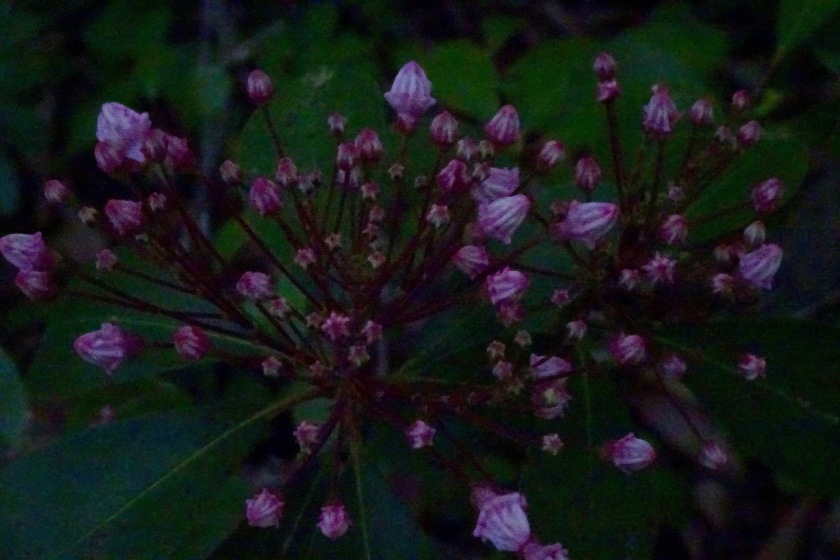
Take an evening stroll with me through Kaul Wildflower Garden, one of more than two dozen gardens at the Birmingham Botanical Gardens.
Alabama’s state tree is the longleaf pine (Pinus palustris), and many young specimens grow along Kaul Wildflower Garden’s trails. This strong native tree is resistant to both disease and hurricane-force storms compared to other pines in the Southeastern US. I must also say that the young trees look a bit like Cousin Itt from The Addams Family.

I especially love the shady areas of this garden, where ferns and bloodroot (Sanguinaria canadensis), with its distinctive leaf shape, thrive.


A special mid-April treat for me was the mountain laurel (Kalmia latifolia) on the cusp of full bloom. The light was a bit low for a photo, but the end result looks like a pink firework against a night sky.

If you have an opportunity to visit Kaul Wildflower Garden, you’ll find many plants growing in abundance, but I encourage you to keep an eye out for the oddballs, such as the drawf crested iris (Iris cristata) below. You won’t have any trouble recognizing it as an iris; it’s just smaller. It’s endemic to the eastern United States, which means you won’t find it anywhere else.

Another sighting on my walk was the red flower below, which I believe is a scarlet catchfly (Silene subciliata). I spotted this plant only once in the garden, but it was close to the trail.

There are also habitat-specific plants, such as the statuesque pitcher plants and stonecrop in the next two photos. Stonecrop is so named for good reason. Here it makes a home on a small boulder.


I’ve only scratched the surface of what there is to see at Kaul Wildflower Garden, much less the Birmingham Botanical Gardens. And of course, its offerings depend on the time of year. For now I will close with the masses of yellow flowers blooming in the bog and surrounding area. Based on the leaf shape, I believe the plants are butterweed (Packera glabella), but I am not positive.


As usual, I used inaturalist.org software to help me identify plants to the best of my ability. If the iNaturalist community of citizen scientists corrects any of these IDs, I will update this post.
Thanks for stopping by!

Love it, Iris cristata is a favorite – the Cousin Itt pines, in Atlanta there was a period when they were popular in containers as a center accent. I would rather have almost anything else.
LikeLike
Oh my, what a weird trend. I value them for what they contribute to natural habitats, but a center accent they are not!
LikeLike
Indeed. Trend was not long lasting.
LikeLiked by 1 person
Going back for fresh photos tomorrow – then I hope iNaturalist will ID my mystery white flower.
LikeLiked by 1 person
I can’t wait to see your new photos!
LikeLike
I found the place – but the flowers were gone.
Utter joy – there is water in the vlei after 3 good days of rain.
Blog post coming.
LikeLiked by 2 people
We are in Maine for the month of May, as we were last year. Your picture of the fern unfolding reminds me that the “Fiddle-head ferns” will be for sale at the grocery soon and only for a short time. I followed the instructions for cooking so that they wouldn’t be harmful.
LikeLike
How fascinating! I have never heard of cooking/eating fiddle-head ferns before.
LikeLike
From the Health Canada website:
“Cook fiddleheads in a generous amount of boiling water for 15 minutes, or steam them for 10 to 12 minutes until tender. Discard the water used for boiling or steaming the fiddleheads.
Cook fiddleheads before sautéing, frying, baking, or using them other foods like mousses and soups.”
Another comment: “It is still unclear what the cause of the illness is, whether a toxin, bacteria or virus – but what is known is that, like bracken ferns, ostrich fern fiddleheads should never be eaten raw or even lightly sautéed.”
Now that is all you ever need to know about them! GP
LikeLiked by 1 person
Love it. Thank you, GP!
LikeLike